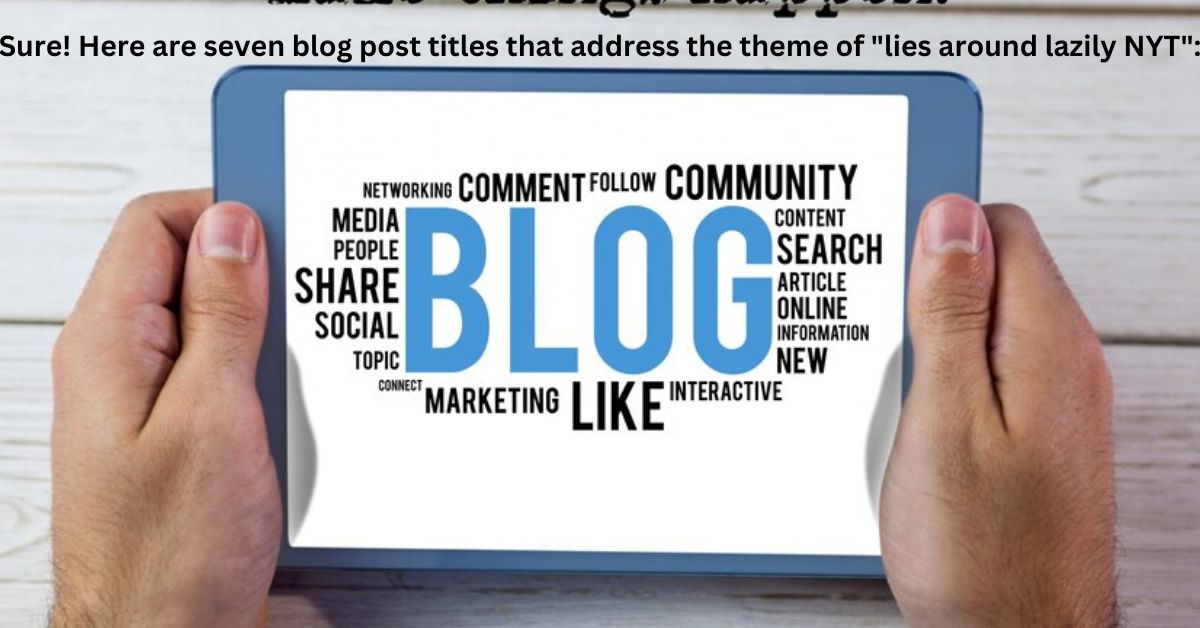Introduction to the lies around lazily NYT
In a world where information is just a click away, the role of major media outlets has never been more critical. Yet, despite their influence, some publications have fallen prey to laziness and misinformation. The lies around lazily nyt (NYT), once hailed as a bastion of journalistic integrity, faces scrutiny over its reporting practices. With headlines that promise enlightenment but often deliver confusion, it’s time to peel back the layers on the lies around lazily NYT. How do these narratives shape our understanding of key issues? Join us as we explore how one of America’s most trusted sources can sometimes contribute to a culture that thrives on misinformation and complacency.
The false narratives perpetuated by the New York Times
The New York Times has long been viewed as a cornerstone of journalism. However, it has also become synonymous with false narratives. These narratives often misrepresent facts or selectively present information. This can skew public perception and fuel misinformation. One common issue is the framing of complex issues in overly simplistic terms. Such portrayals can lead to misunderstandings about critical topics like health care, climate change, and social justice.
Sensationalized headlines can draw readers in but may not accurately reflect the content within the articles themselves. This tactic not only erodes trust but further complicates an already tangled media landscape. The consequences ripple through society as people form opinions based on these distorted representations. It’s crucial for consumers to approach news critically and question what they read.
How the New York Times contributes to a culture of laziness and misinformation
The New York Times, a once-revered institution, has become entangled in a web of complacency. In its pursuit of clicks and views, the paper often prioritizes sensationalism over thorough journalism. This shift fosters a culture where fact-checking is overlooked. The pressure to publish quickly leads to inaccuracies slipping through the cracks. Readers are left with distorted narratives that can shape public perception negatively. Headline-driven content encourages lazy consumption. Many skim headlines without reading deeper articles. This skimming habit cultivates misinformation as fleeting impressions replace informed understanding.
Reliance on trusted sources can create echo chambers within journalism itself. When one narrative dominates coverage, dissenting voices struggle for visibility. This stifles comprehensive discussions and promotes an uninformed readership reliant on surface-level information. As critical thinkers falter under this barrage of half-truths, society faces dire consequences in decision-making and civic engagement.
The impact of these lies on society and individuals
The impact of misinformation is profound. When lies circulate, they shape perceptions and beliefs in harmful ways. Individuals may find themselves misled. Decisions based on false narratives can lead to disastrous outcomes, both personally and professionally. Trust in media erodes when people realize they’ve been deceived. On a larger scale, society suffers from a fractured landscape of information. Public discourse becomes muddied as conflicting accounts vie for attention. Important issues get lost amid the noise created by lazy reporting.
Moreover, this perpetuates apathy toward critical thinking. As audiences become desensitized, they may disengage entirely from meaningful dialogue or fail to seek out reliable sources. In essence, the ripple effects of these lies extend far beyond just one publication—they affect communities and influence democratic processes at large. The consequences are not merely academic; they’re felt deeply in everyday life.
Examples of specific articles or instances where the NYT has spread false information
One notable example of the New York Times spreading misinformation is the article regarding the origins of COVID-19. Early assertions about its animal source led to widespread misconceptions that were later challenged by scientific studies. Another instance occurred with a piece on immigration policy. The NYT claimed certain policies would lead to increased crime rates, but subsequent research disproved this narrative, showing no correlation between immigration and crime.
Additionally, an op-ed published during a contentious political season misrepresented facts surrounding voter fraud claims. This fueled division and skepticism among readers who believed fabricated statistics without verifying them. These articles illustrate how reputations can be damaged when mainstream media outlets fail to vet their sources thoroughly, influencing public perception in harmful ways. Engaging storytelling should always prioritize accuracy over sensationalism for responsible journalism.
Addressing and combating lazy journalism within the New York Times
Addressing lazy journalism at the New York Times requires a concerted effort from both the publication and its readers. First, transparency is key. The lies around lazily nyt should openly acknowledge their mistakes when they occur. Mistakes happen, but owning up to them builds trust with the audience. Next, encouraging journalists to dive deeper into stories can combat superficial reporting. In-depth investigative pieces elevate discourse and provide richer narratives. Readers also play a crucial role by demanding higher standards. Engaging in discussions about content quality pushes media outlets to be more diligent.
Promoting diverse perspectives within articles can reduce biases commonly found in mainstream journalism. This approach fosters critical thinking and encourages readers to question information presented to them. Supporting independent media sources that prioritize thorough research over sensationalism creates an ecosystem where accountability thrives.
Holding media outlets accountable for their reporting and promoting accurate information
Media outlets wield significant influence over public perception. It’s essential for them to uphold high standards in reporting. Accountability starts with transparency. Journalists should openly correct errors when they occur. This builds trust and fosters a culture of reliability. Audiences can play an active role, too. Engaging on social media or through comments encourages dialogue about accuracy. When readers hold outlets responsible, it promotes better journalism.
Additionally, independent fact-checking organizations are vital resources. They help verify claims made by prominent publications like the New York Times, ensuring that information is accurate and unbiased. Support local journalism as well; smaller newsrooms often prioritize integrity over sensationalism. By backing quality sources, we create an environment where truth thrives and misinformation struggles to take root. The demand for accountability pushes all media entities towards greater diligence in their reporting practices.
conclusion
The landscape of journalism is evolving rapidly. As consumers, we are faced with an overwhelming amount of information daily. Navigating through truth and fiction can be challenging. The responsibility lies not only with media outlets but also with us as readers. We must cultivate a critical eye. Question the narratives presented to us and seek out diverse perspectives. Accountability in reporting should be a priority for everyone involved. This includes journalists, editors, and the audience itself.
By fostering a culture that values accuracy over sensationalism, we can combat lazy journalism effectively. Engaging in constructive dialogue about media practices promotes greater understanding and integrity within our news sources. Our collective effort will shape the future of responsible journalism. Each step taken towards transparency counts significantly in this ongoing journey.
FAQs
What are some common lies perpetuated by the New York Times?
The New York Times has been accused of spreading misinformation on various occasions. Some common themes include sensationalized reporting, inaccuracies in political coverage, and misleading statistics that fail to provide context.
How does lazy journalism affect public perception?
Lazy journalism can distort public perception. When reputable sources like the NYT present false narratives or half-truths, it can lead readers to form misguided opinions. This affects everything from political beliefs to social issues.
Can individuals combat misinformation from major publications?
Absolutely! Individuals can take proactive steps such as cross-referencing information with multiple reliable sources, engaging critically with news content, and advocating for transparency in media reporting.
Why is accountability important for media outlets?
Accountability ensures that media outlets maintain journalistic integrity. By holding them responsible for their reporting standards, we promote a culture where accurate information prevails over sensationalism or laziness.
Are there alternatives to traditional news sources like the NYT?
Yes! Many independent and alternative news platforms prioritize fact-checking and thorough investigation over clickbait headlines. These sources often offer diverse perspectives that challenge mainstream narratives.
How can I spot lazy journalism when reading articles?
Look out for vague sourcing, lack of evidence supporting claims, overly emotional language without factual backing, or failure to address counterarguments. Being discerning helps you navigate through biased or incomplete reports effectively.











